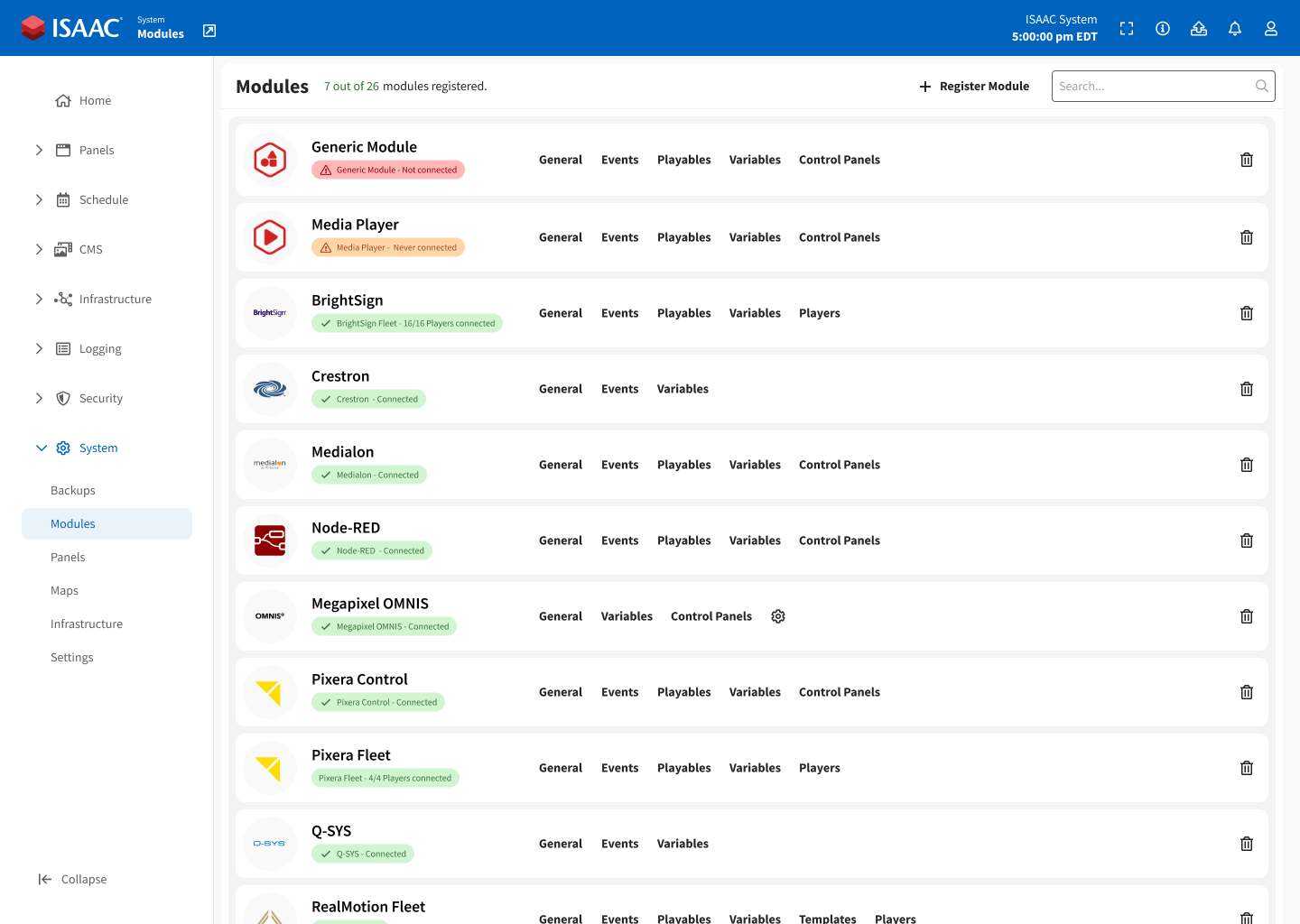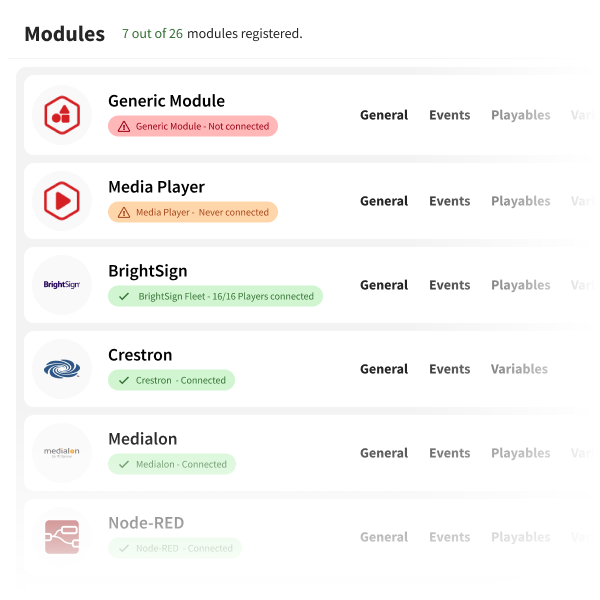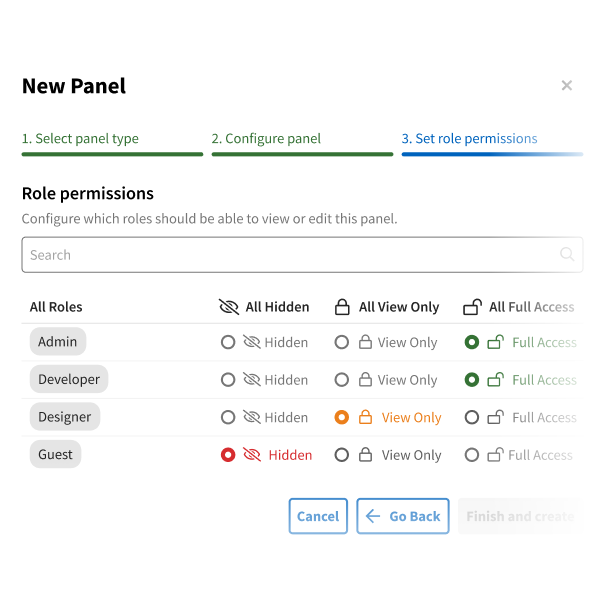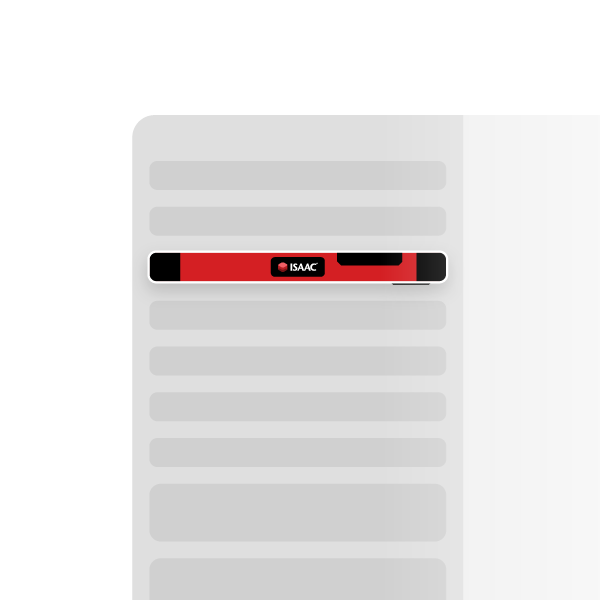Connect external systems with Modules
Connect external systems to ISAAC Workspace with modules. Depending on the type of module, they can publish events, playables, variables, players, templates, and control panels.
Manage essential configuration and features for ISAAC Workspace in one organized place.
Request demo
Connect external systems to ISAAC Workspace with modules. Depending on the type of module, they can publish events, playables, variables, players, templates, and control panels.

Create and manage ISAAC Workspace backups easily. Backup the current system or upload existing backups. Verify backup integrity or download for secure storage.

Choose panel types like ISAAC Connect, embedded web pages, document viewer, or any published module control panel. Easily configure user permissions during panel creation and edit anytime.

Organize maps into folders with intuitive drag and drop. Add maps with markers, then group them with areas to organize your infrastructure visually for easy monitoring and quick issue detection.

Add infrastructure assets using preset profiles like Network Switch, Windows Computer, O3 Multi-Sensor, Web Page, or use the Generic profile to monitor an IP Address.

Have complete control over core system features with an extensive suite of settings. With powerful customization options, you can fine-tune ISAAC Workspace to match your organization’s workflows and requirements.

Quickly check backup names, creation dates, and details through the Info modal. See whether a backup includes full or partial log history.
Re-import prior ISAAC Workspace backups using a guided upload modal. Uploaded backups can then be verified or restored as needed.
Easily generate a backup of the current ISAAC Workspace with one click. By default, only the most recent 3,000 log entries are included to conserve storage.
Use the “Verify” action to confirm if a backup is valid and restorable. Verification ensures the file contains all required ISAAC Workspace data.
Export backups for local storage or external safekeeping. Downloaded backups can be re-uploaded into ISAAC Workspace at any time.
Restore from a backup using the “Restore” action. Useful for data recovery or reverting to a known state.
We partner with leading companies to build integrations that make your work faster, smarter, and easier. Redefining system integration with an overarching ecosystem-based approach.

The Generic Module connects systems without native integration to ISAAC, supporting Events, Playables, Variables, and Control Panels. It syncs these automatically when connected and follows ISAAC’s schedule to play content and trigger events.

The Media Player Module connects non-native systems to ISAAC with full media playback support. It syncs Events, Playables, Variables, and Control Panels automatically. Features include direct media playback, instant play, live previews, and flexible schedule or loop playback modes for reliable content delivery.
Modules can publish Events to the ISAAC Workspace. Depending on the Module type, Events may be pre-determiend or manually defined using a flexible text field for attaching custom data.
Modules can publish Playables to the ISAAC Workspace, each with customizable commands, durations, and descriptions. Playables can be linked to specific Players and optionally force-cached to ensure assets are preloaded for seamless playback.

Modules can publish Variables to the ISAAC Workspace, enabling real-time tracking of data points with support for tagging, logging, alerts, and user-defined composite variables. Each Variable includes its last reported value, timestamp, and for fleet modules, can be linked to specific Players.
View, configure, and manage all media Players linked to a Module. Define network settings, playback mode, resolution, and more. Each Player reports live status and can be set to follow scheduled content or loop individual items, giving you full control over media delivery and performance.
Templates define the structure and rules for creating Compositions in the CMS, including fields, validation, and default values. Modules with media Players allow you to view, group, and manage Templates, ensuring consistent, scalable content across assigned Players.
View, search, and manage all Control Panels linked to a Module. Easily access panel details like name, type, player association, and connection information for streamlined system control.
Broken links occur when Events, Playables, Variables, or Panels are changed or removed from the module sub-system. These links are safe to delete, either all at once, individually, or you can keep them if expected.
Grant or restrict panel access by role. Define permissions as hidden, view only, or full access.

Access remote machines via VNC, SSH, RDP, or Telnet directly in your browser. Configure connection details and control session sharing.
Integrate live web tools or dashboards inside ISAAC Workspace. If embedding is blocked, panels can still open externally.
Preview images and PDFs without leaving ISAAC Workspace. Utilize My Panels to organize related documents with other panels for easy access.
Add custom panels from ISAAC Modules. Configure names, details, and permissions like any other panel.
Place markers to represent devices or variables such as players, lighting, audio, video, or other hardware. Markers show real-time health status and values, and can link directly to dashboards, panels, or other maps.
Group related markers using customizable shapes like rectangles, circles, or draw custom polygons. Areas reflect the combined health state of their contents or can be configured to display the status of a single variable.
Maps are organized with intutive drag and drop in a hierarchical folder structure, making it easy to group locations and systems logically.
Add links for direct navigation to related resources like Panels, Dashboards, or Maps. Configure link behavior to customize your experience.
View a thumbnail of what's currently playing. Click to enlarge the preview and verify output.
Markers can be scaled individually or globally to fit your map layout. Useful for emphasizing infrastructure hierarchy or map resolution.
The Asset Dashboard provides a centralized view of all infrastructure assets. Assets with active warnings or errors are automatically brought to the top, helping you quickly identify and address system issues.
Monitor any device with a pingable IP address. Tracks connection status and ping response time in milliseconds.
Monitor ports with color-coded health and key metrics like status, speed, traffic, SNMP, and ping. Set expected values manually or auto-scan ports based on current usage.
Track temperature, humidity, light, motion, occupant count, and sound levels. Reports include surface, human height, and ceiling values. Connectivity monitored via ping and response time.
Monitor a URL instead of an IP. Tracks ping status, response time, response code, and response size.
Monitor Windows computers with a username, password, and IP. Tracks connection status and ping response time.
Search assets by type, name, description, and tags. Advanced filters allow for searching by IP address and external references.
Manage system identity, timezone, licensing, and email setup from one place.
View system ID, hardware generation, build details, and software version.
Check your current version, Support & Subscription status, and update with one click.
Track user and module licenses, update online or manually.
Configure SMTP to send system alerts and verify with built-in testing.
Set password policies, PIN access, and Express Lane login for faster authentication.
Schedule automatic backups and copy them to an external FTP server.
Control storage by setting maximum saved notifications. Manage historical data for action and activity logs with custom purge rules.
Upload a logo and change the background image to customize the workspace look.
Create and color-code zones for use in the schedule editor. Set calendar views, intervals, playlist rules, and sunrise/sunset scheduling.
Configure virtualization platform connections and UPS monitoring.
Monitor UPS status, set SNMP communities, and enable automatic shutdown.
Manage IP addresses, DNS, and routing with DHCP or static settings.
Send alerts to external systems like Teams, Slack, and any generic webhook.
Schedule a demo to see ISAAC in action, ask questions, and learn more about ISAAC.
ISAAC Workspace is not cloud-hosted. It runs fully on-premises with the ISAAC Platform, giving you complete control. Configure it to fit your network and firewall requirements without relying on external infrastructure.
Learn more